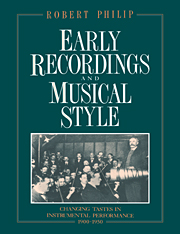3 - Long and short notes
Published online by Cambridge University Press: 22 September 2009
Summary
As the previous chapter has shown, early twentieth-century performers made extensive use of tenutos or agogic accents followed by shortened notes. There was also a very general tendency, in patterns of long and short notes, to lengthen the long notes and hurry and lighten the short notes. To a late twentieth-century listener, the effect is a rather casual, 'throwaway' style of rhythm, because short notes, whether single or in groups, tend to receive less emphasis and clarity of definition than we expect in modern performances, and because the practice of shortening short notes often leads to acceleration. It also produces a tendency to overdot dotted rhythms.
References to this treatment of short notes are very sparse in the writings of the early twentieth century. Writers who argue about tempo rubato and the use of agogic accents rarely make any mention of it. If we take 'accented notes' to include long notes in passages of long and short notes, then the advice by W. H. Breare (already quoted) might imply the shortening of short notes: 'there is nothing more unattractive than the slavish observation of strict time. To execute any passage with grace, it becomes necessary to make a distinction between accented and unaccented notes.'
- Type
- Chapter
- Information
- Early Recordings and Musical StyleChanging Tastes in Instrumental Performance, 1900–1950, pp. 70 - 94Publisher: Cambridge University PressPrint publication year: 1992



